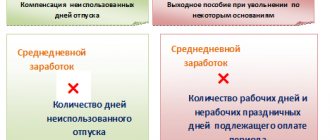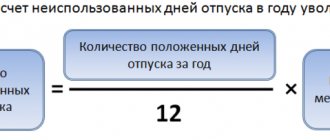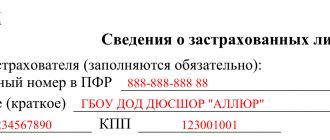Let's look at how to calculate compensation to an employee upon dismissal for unused vacation days. We'll show you how to quickly perform calculations using an online calculator.
The company's management is obliged to provide annual vacations to its employees.
During the rest period, employees retain their position and average earnings. The duration of annual main leave is 28 calendar days. Some categories of citizens are granted increased leave: for example, for minors - 31 days. Also, Article 117 of the Labor Code of the Russian Federation establishes the right for individual employees to receive additional paid leave every year: in harmful, dangerous working conditions, with irregular working hours, working in the regions of the Far North, etc. The following situation often arises: an employer dismisses an employee when he is still did not use all the days of his allotted vacation. In this case, the employee needs to transfer compensation for unused vacation (Article 127 of the Labor Code of the Russian Federation), if he did not want to “take off” these days before dismissal.
At the same time, it is very important to correctly determine the amount of compensation, since non-payment may lead to legal disputes and holding the manager accountable.
Submit electronic reports via the Internet. Kontur.Extern gives you 3 months free!
Try it
Leave compensation upon dismissal
When an employee quits, he must be paid monetary compensation for unused vacation days. The amount of this compensation is calculated using the formula:
| NUMBER OF DAYS OF UNUSED VACATION × AVERAGE DAILY EARNINGS |
To calculate the number of days of unused vacation upon dismissal, you must first determine:
- length of service giving the right to leave;
- the period for which compensation is due.
Let's look at this further with an example.
Compensation upon dismissal, if it is not related to the employee’s initiative
- If the employee has worked for more than six months
An employee has the right to receive full compensation for all 28 days of vacationif he worked for the organization for more than six months and was then fired for one of the following reasons:
- liquidation of an organization (its individual parts) or reorganization;
- reduction of staff (work) or temporary suspension of work;
- entry into active military service;
- revealed unsuitability for work.
Let's go back to our example 1 (employee who worked for 7 months). Upon dismissal of his own free will, his compensation for vacation amounted to 11,133 rubles. 2 kopecks However, if he were fired for one of the reasons stated above, his compensation would be:
682.6 rub. * 28 days = 19,112 rubles. 8 kopecks
- If the employee has worked for less than six months, but more than 15 days
In this case, the employee has the right to receive proportional compensation, that is, according to the formula: average daily salary * number of unused vacation days.
Clarifying points
- In Russian labor legislation there is the concept of “extended vacation” of 42 or 56 calendar days. It is assigned to such categories of employees as teachers.
- Payment of compensation to an employee must be made at the time of dismissal or no later than the day after the dismissed person submits a request for payment.
- Continuous work experience includes both the time of actual work and the time of maintaining a job - time spent on sick leave, non-working holidays and weekends.
- Absenteeism without a valid reason and time off for vacation are not included in continuous work experience; therefore, these days are not included in the calculation when compensating for vacation.
Pavel Timokhin , head of the accounting service "Finguru"
Example of calculating length of service
Let us assume that Sergeev V.I. accepted into the company on May 18, 2017. The employee decided to resign on March 11, 2020. During the period of work, Sergeev was on vacation:
- 21 calendar days of vacation at your own expense - from June 15 to July 5, 2017;
- 28 calendar days of paid leave – from July 4 to July 31, 2018;
- 28 calendar days of paid leave – from August 7 to September 3, 2021.
During his work, Sergeev received disability payments during the following periods:
- from December 6 to December 13, 2018;
- from 12 to 31 March 2021.
Periods of regular paid vacation and sick leave are included in the length of service. Vacation days at your own expense exceeding 14 days are excluded from the length of service. Also, the first working year is increased by these 7 days (21 days – 14 days = 7 days).
So, Sergeev’s length of service will be 2 years 9 months 16 days :
- from May 18, 2021 to May 24, 2021 – 1 year;
- from May 25, 2021 to May 24, 2021 – 1 year;
- from May 25, 2021 to May 24, 2021 – 9 months 16 days.
Cases for full payment of vacation allowance
An employee can count on absolute payment of vacation pay only when he has worked without rest for a long time and then decided to quit. Full payment is also provided in cases where an employee was fired during the vacation period, for example due to downsizing or liquidation of the company. In both cases, monetary compensation is required for all remaining days of rest.
Thus, based on paragraph 28 of the Rules on regular and additional vacations, when the period of work is at least 11 months, upon dismissal of an employee, compensation for unused vacation days is due in full.
There are also the opposite situations, when an employee has taken all the days of his allotted vacation. Then, in the event of dismissal, the employee himself will have to pay for these days - in the form of a deduction in the final payment.
Some employees decide to spend their vacation before leaving, then the final working date is usually taken into account the day the vacation ends. In this case, you can use any vacation period that has not yet been used:
- Another vacation;
- Additional leaves (in connection with work in harmful, dangerous and other types of production);
- Vacation transferred to a future period of time (due to illness, performance of public duty during the vacation period).
The duration of leave will be calculated taking into account the provisions of the Labor Code of the Russian Federation and industry regulations, depending on working conditions.
When registering several types of unspent vacation just before dismissal, the employee has the opportunity to receive additional paid days from the employer in the form of compensation.
Calculation of the period for which compensation is due
To calculate the period for vacation compensation, you must round the period to full months. Based on the data in our example, for Sergeev this period is 2 years 10 months.
When rounding, please note that days that are 15 days from a month or more are rounded to the nearest full month. A period of less than 15 days of the month is not taken into account .
We recommend calculating compensation for unused vacation in proportion to the time worked by the resigning employee. Despite the explanations of Rostrud given in letter dated March 4, 2013 No. 164-6-1. They say the full compensation rule only to workers who are in their first year of employment with a given employer.
Still, the employer has the right to improve the situation of employees. And this way you can avoid unnecessary claims from employees whose interests have been violated when going to court.
REFERENCE
There is positive judicial practice on this score: appeal rulings of the Irkutsk Regional Court dated November 12, 2014 in case No. 33-9318/2014, Murmansk Regional Court dated June 24, 2015 in case No. 33-1833-2015. Also, positive conclusions are presented in the Bulletin of Judicial Practice of the Moscow Court for the 4th quarter of 2015.
How to correctly calculate vacation pay: algorithm
To correctly calculate vacation pay, it is necessary to determine the number of days due to the employee, those days that remain unused for rest, due to the upcoming dismissal.
After this, the calculation will be made based on the number of months that the employee worked: if the employee served several months and more than 15 days, then half a month will be added to the length of service, and if less than 15 days, this period will be excluded from the length of service.
A special formula will help you correctly calculate vacation pay:
O = K / YEAR * S – I, where:
- О – vacation days payable;
- K – the number of vacation days due;
- YEAR – 12 months;
- C – length of service, the duration of which is indicated in months;
- And – days or months excluded from the length of service.
For a clear example, you can calculate the following situation using the formula:
- The employee did not use 40 days of his vacation, with a duration of work of 1 year, was on sick leave for 5 days and on leave without pay for a week.
- According to the formula, the following is obtained: K(40 days)/12 months*12 months-12 days (5+7) = 28 days will go towards payment.
After which the average salary is calculated, excluding social benefits. The total amount should include:
- Salary amount;
- The amount of all possible allowances;
- Prize;
- Other payments subject to tax.
When calculating vacation pay, only the employee’s average earnings are taken that were received in the current year before dismissal.
When calculating the average daily earnings of an employee, it is necessary to take into account a special coefficient that determines the average number of days in a year. In 2017, the coefficient of 29.3 is used, established by Government Decree No. 922 in paragraph 10 of the Regulations. However, there is more than one option for calculating vacation pay:
- When working a full annual period, the average salary is calculated by dividing the total income for the previous year by 12 months and a coefficient of 29.3.
- If the period worked is incomplete with completed months, income is calculated for this number of months.
- In case of incomplete working out of the year and incomplete months, income is calculated according to the number of days in relation to a full and incomplete month.
Each individual organization has the right to set its own terms for calculating the average salary for subsequent payment, in an amount different from the average annual earnings. Such a right must be enshrined in the regulations of an organization or private enterprise and should not detract from the employee’s financial support.
It is worth keeping in mind those forms of payments that will not be included in the calculation of the average salary:
- Interim salary during training, vacation and while performing government duties;
- Compensation payments under the law or in accordance with the statutory documents of the enterprise;
- Sick leave payments;
- Financial assistance and similar payments;
- Other types of payments received due to the performance of duties not related to the working day.
These time periods will also be excluded along with the amount.
The number of vacation days allotted for each month is different for each profession, but they can be divided into three general groups:
- The amount of leave required is up to 28 days - coefficient 2.33;
- The amount of vacation is 30 days for civil servants - coefficient 2.5;
- The duration of vacation is 56 days for teachers - an indicator of 4.67.
To calculate vacation pay, all that remains is to combine the indicators, namely, calculate the product of the received amount of allotted vacation by payment and the amount of earnings per 1 working day. The final amount is expressed in monetary terms (rubles) and is payable.
We calculate the days
So, we have calculated the length of service giving the right to leave and the period for which compensation must be paid. Now you need to determine the number of vacation days that the employee has accumulated during his entire time working in the company.
In general, according to Part 1 of Art. 115 of the Labor Code of the Russian Federation, the duration of vacation is 28 calendar days.
Taking into account the letter of Rostrud dated October 31, 2008 No. 5921-TZ, for one month fully worked in the company, the employee is entitled to vacation in the amount of 2.33 days (28 days / 12 months)
Based on the conditions of our example, Sergeev is entitled to vacation at the rate of 79.22 days ((2 years × 12 months + 10 months) × 2.33 days).
Next, you need to determine how many vacation days he has already used during his time working in this company.
Our Sergeev took 56 days (28 days + 28 days).
The number of days of unused vacation by an employee is determined by the formula (letter of the Ministry of Labor of Russia dated October 28, 2016 No. 14-1/B-1074):
Let's calculate how many days Sergeev is entitled to unused vacation:
79.22 days – 56 days = 23.22 days
Please note that rounding is not required by law. If you still decide to round up and pay compensation only for whole days, do it upward - in favor of the employee. This position is set out in letters of the Ministry of Labor of Russia dated November 2, 2018 No. 14-2/ОOG-8717, the Ministry of Health and Social Development of Russia dated December 7, 2005 No. 4334-17.
In our case, 23.22 days are rounded to 24 days (and not to 23, as we would round based on mathematical rules).
How to calculate
Article 127 of the Labor Code of the Russian Federation states: an employee is entitled to payment of compensation for vacation on the last working day. Every working person has 28 calendar days a year for rest (Article 114 of the Labor Code of the Russian Federation). In the cases specified in the law, citizens are entitled to additional paid days or bonus time for rest, as provided by the employer himself in the collective agreement and local regulations. The part over 28 days is allowed to be replaced by a financial payment at the request of the employee. Let us immediately note that the working year is not equal to the calendar year; the countdown begins each time from the date of employment.
If the employee did not rest during the year worked, then vacation pay upon dismissal is calculated 28 days in advance. If some of the allotted days are used, the remaining days are compensated. Money is not paid if the entire allotted period is used.
Formula for calculating compensation
Compensation for unused vacation by an employee is calculated by multiplying the average daily earnings (ADE) by the number of days of remaining vacation:
| COMPENSATION = SDZ × NUMBER OF UNUSED VACATION DAYS |
How to calculate the average daily earnings is described in detail in our article “How to correctly calculate vacation pay in 2020».
An example of calculating vacation pay before dismissal
The bank employee was hired on May 7, 2014. Three years later, the woman decided to quit her job on May 10, 2021, but before that she wanted to take a vacation.
- The duration of employment is 3 years 5 months and three days.
- The average annual salary is 540 thousand rubles.
You need to calculate the average daily salary and the number of days of annual leave.
O = 30 days of allotted vacation / 12 months a year * 17 months of service, where the allotted number of vacation days before dismissal is 42.5 days, that is, 43 days before rounding.
Or you can calculate it using the coefficient: 17 months of experience * 2.5 = 42.5 = 43 days.
Based on the average annual salary, we calculate the daily average. 540,000 rubles / 12 months / coefficient 29.3. Therefore, the cost of one workday is 1535.8 rubles.
Now you can find out the cost of vacation pay: 43 days * 1535.8 rubles = 66040 rubles. Upon expiration of the vacation days, the employee will be dismissed on his own initiative, based on an application, in this case on June 23, 2021.
Calculation of compensation for an employee on a fixed-term employment contract
In general, the calculation of compensation for an employee on a fixed-term employment contract is no different from a regular one - an open-ended contract. If vacation on a fixed-term contract is set in calendar days, then compensation is calculated using the general formula (see above).
It’s another matter when leave for an employee who finishes work under a fixed-term employment contract should be granted in working days. Such leave is provided for seasonal work, as well as for those with whom a contract has been concluded for a period of up to 2 months. Such employees are entitled to 2 working days of vacation for each month of work (Articles 291 and 295 of the Labor Code of the Russian Federation).
To calculate compensation for unused vacation in working days, use the formula:
Is it allowed to replace vacation with monetary compensation without dismissal?
Replacement with monetary compensation without dismissal is permissible only for the part of the vacation period exceeding 28 calendar days (Article 126 of the Labor Code of the Russian Federation). This happens upon a written request from the employee. It is allowed to replace days with money in excess of the main vacation. Only those categories of employees who are entitled to additional days of rest (disabled people, teachers, doctors, Northern workers, etc.) are entitled to receive monetary compensation instead of rest. Or if the employer has provided additional days for rest in the company’s local regulations. But this is not in all cases:
- The legal norm uses the wording “can be replaced,” which leaves the employer the right to refuse the employee financial compensation. Payment of money instead of providing extra days of rest is at the discretion of management.
- Vacation will not be replaced with money for pregnant women, minors and workers in hazardous and hazardous industries.
It is also not possible to accumulate vacation days for the previous year, and then take part of the double vacation over 28 days in cash. Article 126 of the Labor Code of the Russian Federation, when summing up and transferring vacations from one year to another, allows for the replacement of only part of more than 28 days in each year.
Calculation of compensation for an employee upon dismissal after maternity leave
Compensation for unused vacation to an employee (or employee) upon dismissal after parental leave is calculated in the general manner, as indicated above.
However, keep the following points .
Maternity leave (maternity leave) is included in the length of service that gives the right to paid leave. But maternity leave is not included . It is included in the length of service only if the employee works part-time or at a remote workplace.
Thus, if the entire period for calculating the length of service for vacation, the employee was on maternity leave (and did not work remotely or part-time), and before that she was on maternity leave, then the average daily earnings must be taken for the 12 months that preceded the maternity leave. vacation.
When is it necessary to pay compensation for unused vacation?
All amounts that the employee should receive based on the results of the calculation, including compensation for unused vacation, are transferred on the last working day in this organization. Suppose the person did not work that day. Then compensation must be paid no later than the day following the date on which the employee submitted a request for payment.
For financial or other reasons, a company may delay the payment of compensation to a terminated (or resigned) employee. Failure to pay or pay funds on time is a violation of the law. In this case, for each day of delay, the former employee is provided with an additional payment. The percentage of this payment cannot be less than 1/150 of the key rate of the Central Bank of the Russian Federation. The amount is determined by multiplying this percentage by the unpaid earnings. In addition, the employee may seek compensation for moral damage through the court.
Failure to pay or incomplete payment to the employee of all amounts due entails administrative liability under Parts 6 and 7 of Art. 5.27 Code of Administrative Offences. If an administrative offense is established, the following sanctions will be applied to the employer:
| Primary violation | Repeated violation | |
| To officials | Warning or fine 1,000 - 5,000 rubles. | Fine 10,000 - 20,000 rubles. or disqualification for 1-3 years |
| To legal entities | Fine 1,000 - 5,000 rubles. | Fine 10,000 - 20,000 rubles. |
| To persons conducting business without forming a legal entity | Fine 30,000 - 50,000 rubles. | Fine 50,000 - 70,000 rubles. |
There are situations where failure to pay or underpayment of compensation to an employee is considered a crime. In this case, the provisions of the Criminal Code of the Russian Federation will be applied to the perpetrators. Criminal liability may arise:
- in case of partial non-repayment - after three months of delay in transferring compensation;
- in case of non-payment - after two months of delay.
At the same time, the employer must have a selfish motive for delaying compensation. For example, an organization has funds in its current account to pay a settlement, but the manager used them for his own personal interests. Authorized persons may face a fine, removal from office, forced labor, or even, in especially severe cases, imprisonment (Article 145.1 of the Criminal Code of the Russian Federation).
Submit electronic reports via the Internet. Kontur.Extern gives you 3 months free!
Try it
Calculation of compensation for an employee upon dismissal on the last day of the month
Often employees want to work for a full month and then leave for a new job. In this case, this last month must be This position is reflected in the letter of Rostrud dated July 22, 2010 No. 2184-6-1.
EXAMPLE
For example, Malkova was hired by the company on April 3, 2021. She decided to resign of her own free will on the last day of July - July 31, 2021.
This means that for the calculation we take the period from August 1, 2021 to July 31, 2020.
To calculate average daily earnings we use the standard formula.
Counting Tools
To calculate and specify the payment amount, the following data is provided:
- Work experience in a specific organization;
- The amount of time excluded from the length of service;
- The rest period assigned to the employee for the entire period of work;
- The number of vacation days spent at the time of dismissal.
Time excluded from the length of service will be considered absence from the workplace without any valid reason and the period that comes after one and a half years of maternity leave.
Payments to the employee are usually made on the date of dismissal, when the employer hands over the documents. The settlement amount usually includes the employee’s salary and additional payment (compensation).
Calculation of compensation for internal and external part-time workers
It seems strange that when working part -time, you are also entitled to leave. In fact, this is true. When working for the same company under two different contracts, the right to vacation arises under both contracts. This means the right to compensation for unused vacation too.
Compensation is calculated separately for each employment contract, based on length of service and average salary. There are no special conditions for calculating compensation for internal part-time workers . Therefore, use standard formulas for calculations (see above).
When an external part-time worker is dismissed, he is also entitled to compensation for unused vacation. It is calculated according to the standard scheme. specific calculation features have been established for external part-time workers. Shortened working hours are not taken into account in this case.
Additional payment for early dismissal
The Labor Code of the Russian Federation does not contain additional payments for early termination of a fixed-term employment contract. However, the employer can provide for them by stipulating this point in the employment contract.
When additional compensation can be paid:
- If a fixed-term contract is terminated early by agreement of the parties, and the agreement specifies the payment of additional compensation and its amount.
- If the employment contract itself contains a condition that upon its early termination, the employer assigns an additional payment, for example, severance pay.
There are no other cases of additional compensation payments for early termination of a fixed-term contract. That is, this is possible solely at the request of the employer himself.
The billing period has been fully worked out
If the billing period has been fully worked out, determine the average daily earnings using the formula:
| Average daily earnings | = | Earnings accrued for the billing period | : | 12 | : | Average monthly number of calendar days (29.3) |
This calculation procedure is established in part 4 of article 139 of the Labor Code of the Russian Federation, paragraph 1 of clause 10 of the Regulations approved by Decree of the Government of the Russian Federation of December 24, 2007 No. 922.
An example of how to determine the average daily earnings for compensation for unused vacation not related to dismissal. The billing period has been fully worked out
To the driver of the organization Yu.I. Kolesov’s salary is set at 20,000 rubles. In May 2021, he wrote an application to replace unused additional leave for 2015 with monetary compensation. In the same month, compensation was accrued.
The billing period - from May 1, 2015 to April 30, 2021 - has been fully worked out. During the pay period, the employee was only paid a salary; there were no other payments.
The accountant calculated the average daily earnings to pay compensation for Kolesov as follows: 240,000 rubles. : 12 months : 29.3 days/month = 682.59 rub./day.
The billing period has not been fully worked out
If the billing period has not been fully worked out, calculate the average daily earnings as follows:
| Average daily earnings | = | Earnings accrued for the billing period ______________________________________________________________________________________________ | ||||
| 29,3 | × | Number of full calendar months in the billing period | + | Number of calendar days in partial calendar months (calendar month) | ||
Calculate the number of calendar days falling on an incomplete calendar month of the billing period using the formula:
| Number of calendar days in an incompletely worked calendar month | = | 29,3 | : | Number of calendar days of the month | × | The number of calendar days falling on present time in an incompletely worked month |
If in the billing period the employee did not fully work for several calendar months, then determine the number of calendar days not fully worked for each of them, and then add them up. This will result in the indicator “Number of calendar days in calendar months not fully worked.”
This procedure for calculating average daily earnings is provided for in paragraphs 2 and 3 of clause 10 of the Regulations, approved by Decree of the Government of the Russian Federation of December 24, 2007 No. 922.
This procedure for determining the average daily earnings also applies in cases where an employee is assigned part-time work (clause 12 of the Regulations approved by Decree of the Government of the Russian Federation of December 24, 2007 No. 922).
Situation: is a month considered to be fully worked when determining the average daily earnings for calculating compensation for unused vacation not related to dismissal? The employee was not hired on the first day of the month, but worked all working days as scheduled.
No, it doesn't count.
Since the employee was not hired from the beginning of the month (for example, from Monday, and the first days of the month fall on the weekend: the 1st day falls on Sunday, the employee was hired from the 2nd day), calculate the average daily earnings taking into account that that he did not fully work the first month of the billing period. Based on the literal meaning of paragraph 10 of the Regulations, approved by Decree of the Government of the Russian Federation of December 24, 2007 No. 922, the procedure for calculating average daily earnings depends on the period of time worked and calendar days falling on the time worked during the month. Do not include days when the employee has not yet been hired by the organization in the number of calendar days included in hours worked.
The employee was hired (started work) on Monday. It is from this moment that he performs his labor function. Therefore, it is necessary to exclude from the calculation the weekends preceding the employee’s hiring.
An example of how to determine the average daily earnings for compensation for unused vacation not related to dismissal. During the period of validity of the employment contract, the employee was ill
In 2021, worker A.I. Ivanov has the right to annual leave of 40 calendar days. Of these: – 28 calendar days – main vacation; – 12 calendar days – additional leave.
In May 2021, Ivanov wrote an application to replace additional leave with monetary compensation. In the same month, compensation was accrued.
The billing period - from May 1, 2015 to April 30, 2021 - has not been fully worked out. From June 23 to June 25, 2015, the employee was ill. The period of temporary disability and the amount of sick leave benefits are excluded from the calculation of average earnings. The remaining months of the billing period have been fully worked out.
During the billing period, the employee was accrued (in addition to sick leave benefits) 200,000 rubles.
The accountant calculated Ivanov's average daily earnings as follows.
Fully worked months are taken into account in the calculation of average daily earnings in the amount of the average monthly number of calendar days - 29.3. In June, the accountant included 26.37 days in the calculation. (29.3: 30 days × 27 days).
The average daily salary of an employee is: 200,000 rubles. : (29.3 days/month × 11 months + 26.37 days) = 573.61 rub./day.
From a letter to the editor:
“Our organization hired workers for the season from April 15 to September 30 to carry out work on repairing ski slopes.
Employee Kovalevsky A.I. submitted on July 5 a certificate of incapacity for work for the period from June 5 to June 30 in connection with a domestic injury due to alcohol intoxication. Currently, the employee continues to be ill.
The management of the organization decided to dismiss A.I. Kovalevsky. and hire another seasonal worker.
Do we have the right to dismiss A.I. Kovalevsky? before the end of the contract? What payments need to be made?
Sincerely, Chief Accountant Oleg Petrovich"
Dear Oleg Petrovich, as far as I understand from your letter, we are talking about the dismissal of a seasonal worker. In this case, the employment contract with a seasonal worker may be terminated on the grounds provided for in Art. 301 of the Labor Code of the Republic of Belarus (hereinafter referred to as the Labor Code):
1) the employee’s refusal to be transferred to work in another location together with the employer;
2) refusal to continue work due to a change in significant working conditions;
3) refusal to continue work in connection with a change in the owner of the property and (or) reorganization of the organization;
4) suspension of work for a period of more than 2 weeks for reasons of a production nature or a reduction in the volume of work by the employer;
5) absence of a seasonal worker from work due to temporary incapacity for work continuously for more than 1 month. In case of loss of ability to work due to a work injury or occupational disease, as well as when legislation establishes a longer period for retaining a place of work (position) in case of a certain disease, for seasonal workers the place of work (position) is retained until the restoration of working capacity or the establishment of disability, but no more than until expiration of the term of work under the employment contract;
6) violation by the employer of labor legislation, collective agreement, or employment contract.
From your letter it follows that the employee has been absent from work continuously since June 5, i.e. for more than a month now. And the cause of temporary disability is not an occupational disease or work injury. In this case, the employer would not have the right to dismiss the employee before the end of work specified in the employment contract. Thus, the management of your organization has made a decision that does not contradict the Labor Code. On the day of dismissal of a seasonal worker, the employer is obliged to make the final payment and issue a work book.
The concept of “seasonal worker”
Let's take a closer look at what you need to pay attention to when hiring seasonal workers.
First, you need to understand that the concepts of “seasonal work” and “seasonal worker” are not identical. Seasonal workers are employees engaged in work that, due to natural and climatic conditions, is not performed all year round, but during a certain period (season) not exceeding 6 months. The list of seasonal work is approved by the Government of the Republic of Belarus or an authorized body (Article 299 of the Labor Code).
Currently, the list of seasonal work, approved by Decree of the Ministry of Labor of the Republic of Belarus dated April 14, 2000 No. 56 (hereinafter referred to as List No. 56), includes 22 items. Work on the preparation, maintenance and repair of ski slopes, slopes for cross-country skiing, snowboarding, training and tubing slopes is included in List No. 56 by Decree of the Ministry of Labor and Social Protection dated 04.05.2006 No. 56 “On introducing an amendment to the Decree of the Ministry of Labor of the Republic of Belarus dated April 14, 2000 city No. 56."
The second important criterion is the duration of the work to be no more than 6 months.
Example 1
The summer cafe worker is not seasonal
A waiter has been hired to work in a summer cafe. A fixed-term employment contract was concluded with him for a period from May 1 to August 30. The employee was on sick leave (general illness) from May 10 to June 15.
Since work in summer cafes is not listed in List No. 56, the hired employee is not seasonal. According to the provisions of Art. 301 of the Labor Code do not apply to him.
Returning to your question in the letter, I will note once again: seasonal workers are accepted to perform the work provided for in List No. 56 for a period of no more than 6 months. You fulfilled both criteria when hiring A.I. Kovalevsky.
When hiring a seasonal worker, the seasonal nature of the work must be specified in the employment contract. Otherwise, the employee will not be recognized as a seasonal worker. I advise you to once again refer to the employment contract with A.I. Kovalevsky, since I am answering based on the assumption that A.I. Kovalevsky. - seasonal worker.
For employees engaged in seasonal work, wages are calculated in accordance with the general procedure. The amount of remuneration of employees, incl. additional payments are established by the employer on the basis of the employment contract (Article 63 of the Labor Code).
Seasonal workers working under employment contracts are subject to compulsory state social insurance (Article 7 of the Law of the Republic of Belarus dated January 31, 1995 No. 3563-XII “On the fundamentals of state social insurance”; hereinafter referred to as Law No. 3563-XII). Organizations providing work and citizens themselves are payers and pay mandatory insurance contributions to the Social Security Fund, and when insured events occur, citizens acquire the right to payments under state social insurance (Article 10 of Law No. 3563-XII).
Providing benefits for temporary disability
Seasonal workers, like other workers engaged in activities during the period of which they are covered by state social insurance and for them, as well as by themselves, in cases provided for by law, are paid mandatory social insurance contributions, have the right to receive benefits for temporary disability. Temporary disability benefits are awarded in the following cases:
– loss of ability to work due to illness or injury at home;
– caring for a sick family member, incl. for a sick child - up to 14 years old (disabled child up to 18 years old);
– care for a child under 3 years of age and a disabled child under 18 years of age in the event of illness of the mother or another person actually caring for the child;
– care for a disabled child under 18 years of age during his sanatorium-resort treatment, medical rehabilitation (clause 2 of Chapter 1 of the Regulations on the procedure for providing benefits for temporary disability and pregnancy and childbirth, approved by Resolution of the Council of Ministers of the Republic of Belarus dated June 28, 2013 No. 569, hereinafter referred to as Regulation No. 569).
Before the adoption of Regulation No. 569, temporary disability benefits were assigned to seasonal workers for no more than 75 calendar days in total (clause 10 of the previously existing Regulations on the procedure for providing temporary disability and maternity benefits, approved by the resolution of the Council of Ministers of the Republic of Belarus dated September 30 .1997 No. 1290).
Payment of compensation for unused vacation upon dismissal
Labor leave is provided to all employees of the organization, including seasonal ones. Leave is not granted only to those employees who perform work under a civil contract (for example, a contract).
After employment, labor leave is granted no earlier than after 6 months of work in the organization (part one of Article 166 of the Labor Code). Before the expiration of this period, the employer can provide only part of the leave in proportion to the time worked. In this case, less than 14 calendar days of vacation cannot be granted (part four of Article 166 of the Labor Code).
Upon dismissal (regardless of the reason) of a seasonal worker who did not use or did not use the labor leave in full, monetary compensation is paid (Article 179 of the Labor Code). Cash compensation for unused labor leave is paid on the day of dismissal. The amount of compensation is determined as the product of average daily earnings and the number of calendar days of vacation for which compensation is paid.
As a general rule, average earnings for determining the amount of compensation are calculated based on wages for 12 calendar months (from the 1st to the 1st day) preceding the month of payment of compensation (Chapter 2 of the Instructions on the procedure for calculating average earnings retained in the cases provided for legislation approved by Resolution of the Ministry of Labor of the Republic of Belarus dated April 10, 2000 No. 47; hereinafter referred to as Instruction No. 47).
When calculating compensation for the dismissal of a seasonal worker, the number of months cannot exceed 6 based on the very concept of a seasonal worker. In this case, average earnings are determined based on wages for full months worked before the month in which compensation is calculated. Average daily earnings are determined by dividing the wages actually accrued to the employee for the months taken to calculate average earnings by the number of these months and by the average monthly number of calendar days equal to 29.7.
The procedure for calculating the duration of labor leave in proportion to the time worked is set out in Art. 177 TK.
Example 2
Calculation of compensation for unused vacation
From July 20, a seasonal employee leaves the organization at his own request. Cash compensation for unused vacation is paid in proportion to the time worked for 9 calendar days.
To calculate the average daily earnings, the period March – June is taken.
The employee was accrued the following amounts of wages:
March – 565 RUR;
April – 664 rubles;
May - 438 rubles;
June – 540 rub.
Average daily earnings will be 18.58 rubles. ((565 rub. + 664 rub. + 438 rub. + 540 rub.) / 4 months / 29.7).
The amount of compensation for unused vacation is 167.22 rubles. (RUB 18.58 × 9 days).
Severance pay for seasonal workers
The Labor Code provides that severance pay is paid to employees upon termination of an employment contract on such grounds as (Article 42 of the Labor Code):
– liquidation of an organization, termination of the activities of a branch, representative office or other separate division of the organization;
– the employee’s inadequacy for the position held or the work performed due to a health condition that prevents the continuation of this work;
– inconsistency of the employee with the position held or the work performed due to insufficient qualifications, which prevents the continuation of this work, etc.
I would like to draw your attention to the specifics of paying severance pay to seasonal workers.
Severance pay to seasonal workers is paid in the following cases:
– suspension of work for a period of more than 2 weeks for reasons of a production nature or a reduction in the volume of work for the employer - in the amount of weekly average earnings;
– violation by the employer of labor legislation, a collective agreement, an employment contract, as well as in the case of an employee being called up for military service – in the amount of 2 weeks’ average earnings (Article 302 of the Labor Code).
In other cases, severance pay is not paid to seasonal workers.
Local acts of the organization may provide for other situations when severance pay is paid.
The average earnings for determining the amount of severance pay are determined based on the wages accrued to the employee for 2 calendar months of work (from the 1st to the 1st day) preceding the month of dismissal. The total amount due for payment is determined by multiplying the average daily earnings by the number of working days to be paid (Chapter 3 of Instruction No. 47).
Example 3
Calculation of severance pay when dismissing a seasonal worker
As of July 20, the organization is laying off a seasonal worker due to a reduction in the volume of work. He was given a 5-day work week. To calculate average daily earnings, the period May–June is taken.
The employee was accrued the following amounts of wages:
May - 438 rubles;
June – 540 rub.
He worked all working days according to the production calendar:
in May – 21 days;
in June – 22 days.
Average daily earnings are 22.74 rubles. ((438 rub. + 540 rub.) / (21 days + 22 days)).
The amount of severance pay is 227.4 rubles. (RUB 22.74 × 10 days).
I remind you that severance pay in connection with the termination of employment agreements (contracts), if they are paid in cases for which legislative acts establish minimum guaranteed amounts of such payments, in amounts not exceeding these established minimum guaranteed amounts, are exempt from income tax.
When paying severance pay that is not provided for by law, or paying benefits in an amount greater than its minimum guaranteed amount provided for by law, the amount of such benefits or the amount of their excess over the minimum amount is subject to income tax in the generally established manner.
Let's return to your question. Upon dismissal of employee Kovalevsky A.I. In addition to wages, compensation for unused vacation must be paid. He is not paid severance pay.
I hope I was able to answer your questions.
Sincerely, Olga Pavlovna
Withholding from vacation payments
Compensation payments for an unused vacation period upon dismissal, as well as when assigning vacation pay in other cases, are subject to insurance premiums for the employee and income tax (NDFL).
It is prohibited to deduct the amount of paid leave from an employee if one of the following reasons for dismissal exists:
- lack of desire to change position from current to another: due to illness or lack of availability of a vacant position at a specific enterprise;
- reduction, abolition, liquidation of an enterprise;
- judicial reinstatement of the former employee to his position;
- conscription service;
- recognition of the employee's incapacity for work;
- force majeure situations;
- death of the head of an individual business.
In other cases, when the employee has used vacation and plans to quit, but has not worked for the established period, it is recommended to warn him of subsequent penalties.
Summarized accounting
For an employee who has accumulated working time records, calculate compensation in the usual manner. That is, calculate the average daily, not the average hourly earnings (clauses 9 and 13 of the Regulations approved by Decree of the Government of the Russian Federation of December 24, 2007 No. 922).
If an employee who has been assigned a summary account has fulfilled his monthly working hours, consider that he has worked the entire pay period (even if he rested on days that are considered working days for employees with daily accounting). In this case, calculate the average daily earnings in the generally established manner.
An example of how to determine the average daily earnings for compensation for unused vacation not related to dismissal. The employee is provided with a summarized recording of working time. The billing period has been fully worked out
To the driver of the organization Yu.I. Kolesov has been provided with a summarized recording of working time. The accounting period is a month. The collective agreement for the organization’s drivers provides an additional 7 calendar days of vacation.
In May 2021, the employee wrote an application to replace additional leave of 7 calendar days with monetary compensation.
Calculation period for calculating compensation for unused additional leave: May 2015 – April 2021.
Employee salary – 25,000 rubles. Based on the results of the accounting period, Kolesov has overtime hours (overtime).
To calculate overtime, an organization uses the average monthly number of working hours. In 2015, this figure for a 40-hour work week is 164.25 hours (1971 hours: 12 months). Thus, the hourly rate for calculating overtime is 152.21 rubles. (RUB 25,000: 164.25 hours).
In 2021, the average monthly number of working hours for a 40-hour work week is 164.5 hours (1974 hours: 12 months). Thus, the hourly rate for calculating overtime is 151.98 rubles. (RUB 25,000: 164.5 hours).
In summary accounting, overtime is considered to be hours worked in excess of the standard working time established for the accounting period. At the same time, work on holidays is included in the monthly working time standard (clause 1 of clarification No. 13/p-21, approved by resolution of the USSR State Committee for Labor, the Presidium of the All-Union Central Council of Trade Unions of August 8, 1966 No. 465/P-21).
Overtime work must be paid as follows:
- for the first two hours falling on average on each working day of the accounting period - no less than one and a half times;
- for the following hours - no less than double the amount.
This is stated in paragraph 5.5 of the Recommendations, approved by resolution of May 30, 1985 of the USSR State Committee for Labor No. 162, All-Union Central Council of Trade Unions No. 12-55. The fact that this document is still in force and does not contradict labor legislation was confirmed by the Supreme Court of the Russian Federation in its decision of October 15, 2012 No. AKPI12-1068.
During the billing period, the employee was accrued:
| Month of billing period | Number of working hours according to a schedule drawn up within the normal working hours | Number of hours actually worked (including overtime) | Salary for time worked, rub. | Additional payment for overtime work, rub. | Salary, total, rub. |
| 2015 | |||||
| May | 143 | 145 | 25 000 | 456,63 | 25 456,63 |
| June | 167 | 168 | 25 000 | 228,32 | 25 228,32 |
| July | 184 | 186 | 25 000 | 456,63 | 25 456,63 |
| August | 168 | 168 | 25 000 | 0 | 25 000 |
| September | 176 | 178 | 25 000 | 456,63 | 25 456,63 |
| October | 176 | 176 | 25 000 | 0 | 25 000 |
| November | 159 | 159 | 25 000 | 0 | 25 000 |
| December | 183 | 184 | 25 000 | 228,32 | 25 228,32 |
| 2016 | |||||
| January | 120 | 122 | 25 000 | 455,94 | 25 455,94 |
| February | 159 | 159 | 25 000 | 0 | 25 000 |
| March | 168 | 168 | 25 000 | 0 | 25 000 |
| April | 168 | 168 | 25 000 | 0 | 25 000 |
| Total | 1971 | 1991 | 300 000 | 2282,47 | 302 282,47 |
The billing period was fully worked out (there were no days excluded from the billing period).
The accountant calculated the employee's average daily earnings as follows: RUB 302,282.47. : 12 months : 29.3 days/month = 859.73 rub./day.
An example of how to determine the average daily earnings for compensation for unused vacation not related to dismissal. The employee is provided with a summarized recording of working time. The billing period has not been fully worked out
In 2021, the driver of the organization Yu.I. Kolesov has the right to annual leave of 40 calendar days. Of these: – 28 calendar days – main vacation; – 12 calendar days – additional leave.
In May 2021, Kolesov wrote an application to replace additional leave with monetary compensation. In the same month, compensation was accrued.
The billing period - from May 1, 2015 to April 30, 2021 - has not been fully worked out. From April 1 to April 5, 2021, the employee was sick.
During the billing period, the employee was accrued (in addition to sick leave benefits) 240,000 rubles.
The accountant calculated the employee's average daily earnings as follows.
Fully worked months are taken into account in the calculation of average daily earnings in the amount of the average monthly number of calendar days - 29.3. In April, the accountant included 24.4167 days in the calculation. (29.3: 30 days × 25 days).
The average daily salary of an employee is: 240,000 rubles. : (29.3 days/month × 11 months + 24.4167 days) = 692.21 rub./day.











